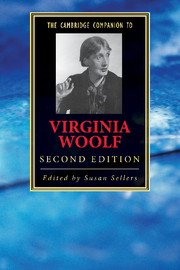Book contents
- Frontmatter
- 1 Bloomsbury
- 2 Virginia Woolf’s early novels: Finding a voice
- 3 From Mrs Dalloway to The Waves: New elegy and lyric experimentalism
- 4 The novels of the 1930s and the impact of history
- 5 Virginia Woolf’s essays
- 6 Virginia Woolf, modernism and modernity
- 7 The socio-political vision of the novels
- 8 Woolf’s feminism and feminism’s Woolf
- 9 Virginia Woolf and sexuality
- 10 Virginia Woolf, Empire and race
- 11 Virginia Woolf and visual culture
- 12 Virginia Woolf and the public sphere
- Guide to further reading
- Index
4 - The novels of the 1930s and the impact of history
Published online by Cambridge University Press: 28 July 2010
- Frontmatter
- 1 Bloomsbury
- 2 Virginia Woolf’s early novels: Finding a voice
- 3 From Mrs Dalloway to The Waves: New elegy and lyric experimentalism
- 4 The novels of the 1930s and the impact of history
- 5 Virginia Woolf’s essays
- 6 Virginia Woolf, modernism and modernity
- 7 The socio-political vision of the novels
- 8 Woolf’s feminism and feminism’s Woolf
- 9 Virginia Woolf and sexuality
- 10 Virginia Woolf, Empire and race
- 11 Virginia Woolf and visual culture
- 12 Virginia Woolf and the public sphere
- Guide to further reading
- Index
Summary
'Were they like that?' Isa asked abruptly . . .
'The Victorians,' Mrs Swithin mused. 'I don't believe,' she said with her odd little smile, 'that there ever were such people. Only you and me and William dressed differently.'
'You don't believe in history,' said William.
Virginia Woolf's fiction explores the nature of the human condition: what makes up our consciousness when we are alone and when we are with others, how we live in time, and to what extent our natures are determined by the accidents of gender, class and historical moment. In her novels, the Great War (as it was always referred to, until the Second World War) was the defining moment, the line that separated the past from the present, always seen as an abyss or a watershed. Jacob's Room (1922) portrays middle-class English society before the war; Mrs Dalloway (1925) portrays it after the war. To the Lighthouse (1927) contrasts the two, separating them from one another with the 'Time Passes' section. Woolf began To the Lighthouse with the intention of exploring who her parents had been, but in the process of recording them she relocated them in a post-war perspective, seeing them through the affectionate yet critical gaze of a modern young woman, Lily Briscoe, who is painting a portrait of Mrs Ramsay. The effect of Lily's viewpoint in the novel was to begin to isolate and set in perspective the elements that made up the Ramsays' (and the Stephens') cultural consciousness, so that Woolf could see in what ways their particular historical moment had determined who her parents were, as well as what they believed and how they behaved.
- Type
- Chapter
- Information
- The Cambridge Companion to Virginia Woolf , pp. 70 - 88Publisher: Cambridge University PressPrint publication year: 2010
- 4
- Cited by



